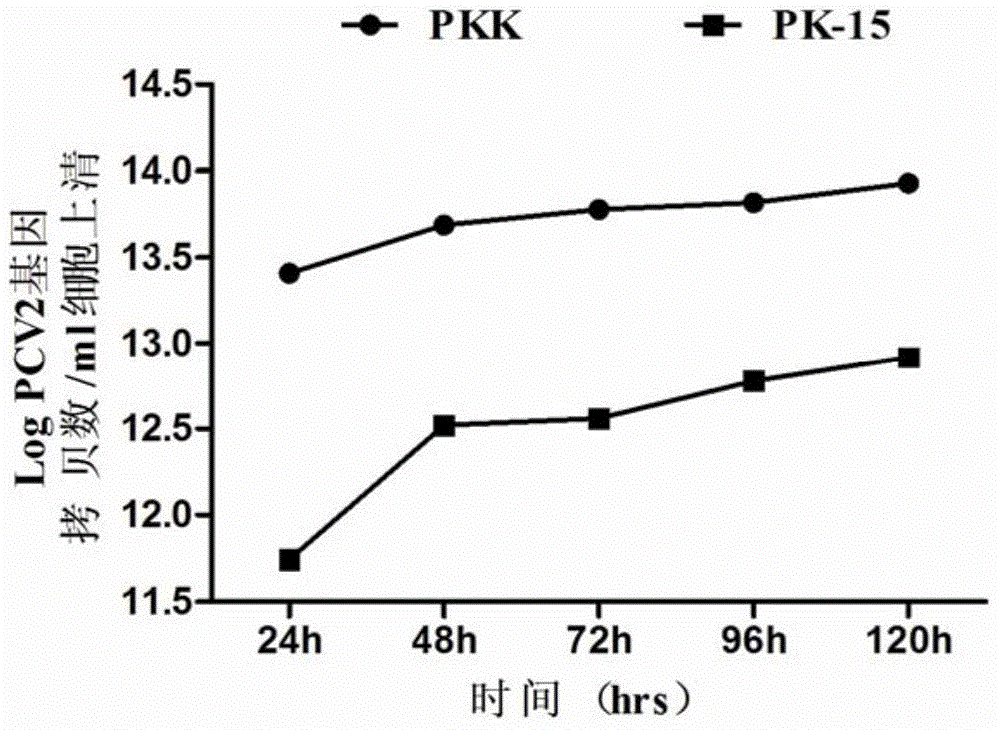Method of preparing porcine circovirus 2 type sensitive cell line, cell line prepared therethrough, and application of the cell line
A porcine circovirus and sensitive cell technology, applied in the direction of microorganism-based methods, biochemical equipment and methods, cells modified by introducing foreign genetic material, etc., can solve the difficulty in obtaining PCV2 virus, affecting PCV2 research and development, and PCV2 cultivation Problems such as low titer
- Summary
- Abstract
- Description
- Claims
- Application Information
AI Technical Summary
Problems solved by technology
Method used
Image
Examples
Embodiment 1
[0022] Preparation of porcine circovirus type 2 sensitive cell line
[0023] Serial limiting dilution of 1PK15 cells for cell cloning
[0024] The preserved PK15 cells in the logarithmic growth phase without porcine circovirus type 1 (PCV1) and type 2 (PCV2) contamination were digested by trypsin into single cells, serially diluted, and then cultured in 96-well cell plates , at 37°C 5% CO 2 Cultivate under conditions for 10-14 days, select cell wells with single cell growth, subclone the cells, and subclone them continuously for 3 times to obtain subclone cell lines.
[0025] 2 Virus susceptibility test of cloned cells
[0026] Add different subclones of PK15 cells to 96-well cell culture plates at an amount of 200 μL per well, and place at 37°C in 5% CO 2 After culturing in the incubator for 12 hours, inoculate the PCV2SH strain virus liquid, inoculate 100 μL in each well, repeat 4 wells for each dilution, and finally add 100 μL of MEM cell maintenance solution containing ...
Embodiment 2
[0030] Proliferation of High Titer Porcine Circovirus Type 2
[0031] 1 Proliferation of the virus
[0032] Inoculate the obtained PKK cells in a cell culture flask, add MEM cell growth solution containing 5% fetal bovine serum, and culture at 37°C for 72 hours to form a monolayer of cells, digest and disperse the cells with trypsin and press M.O.I.=0.1 and Cells were inoculated with PCV2SH strain synchronously, added with MEM cell maintenance solution containing 2% fetal bovine serum, placed at 37°C for daily observation, after 96 hours of culture, cell pathological changes could be observed, manifested as cell aggregation, shedding and straining. When the lesion reaches more than 80%, take it out and freeze it at -20°C, and measure the virus content with IFA after freezing and thawing.
[0033] 2 virus TCID 50 determination
[0034] Digest PKK cells in the logarithmic growth phase to prepare 6×10 4 cell / mL PKK cell suspension, add 200 μL per well to a 96-well cell cultur...
Embodiment 3
[0037] Characterization of PKK Cell Lines
[0038] 1 cell morphology
[0039] Equal amounts of PK15 cells and PKK cells were inoculated into 6-well plates, and MEM cell culture medium containing 5% fetal bovine serum was added, cultured at 37°C for 72 hours, and the morphological differences were observed after the cells covered a monolayer. Compared with PK15 cells, the morphology of PKK cell clones is not a typical spindle shape, the cell shape is shortened vertically, and thickened horizontally, and the cell edges are much smoother and more tidy. The cells grow in the form of islands, and the cells grow into a monolayer in uniform size.
[0040] 2 Cell growth speed
[0041] Take about 1×10 5 PK15 cells and PKK cells were seeded in 6-well plates and cultured in MEM cell growth medium containing 5% fetal bovine serum, cultured at 37°C, and the cells in one of the wells were taken at 8, 16, 24, 32 and 48 hours respectively. Staining and counting were performed in triplicat...
PUM
| Property | Measurement | Unit |
|---|---|---|
| Titer | aaaaa | aaaaa |
Abstract
Description
Claims
Application Information
 Login to View More
Login to View More - R&D
- Intellectual Property
- Life Sciences
- Materials
- Tech Scout
- Unparalleled Data Quality
- Higher Quality Content
- 60% Fewer Hallucinations
Browse by: Latest US Patents, China's latest patents, Technical Efficacy Thesaurus, Application Domain, Technology Topic, Popular Technical Reports.
© 2025 PatSnap. All rights reserved.Legal|Privacy policy|Modern Slavery Act Transparency Statement|Sitemap|About US| Contact US: help@patsnap.com



